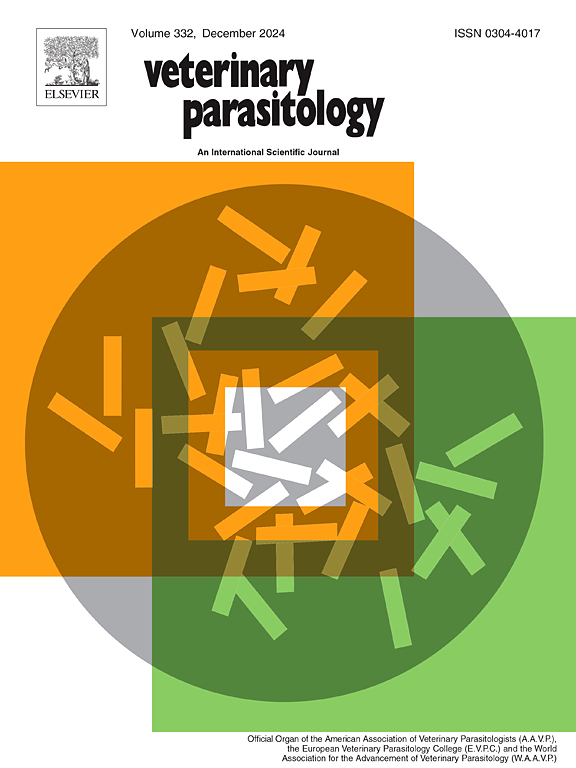Prevalence of spurious parasites identified in feces of dogs and correlation with true canine parasitism
IF 2
2区 农林科学
Q2 PARASITOLOGY
引用次数: 0
Abstract
Spurious parasites are commonly found in canine feces as dogs often practice coprophagy, predation, and scavenging behaviors. Our main study objectives were to determine the prevalence and variety of spurious parasites identified in feces of client-owned dogs and a possible correlation between the prevalence of spurious and true parasites in dogs. Additionally, the prevalence of spurious parasites was statistically compared by age, sex, and reproductive status of dogs and regions. A total of 48,509 fecal examination results were retrieved from Zoetis Reference Laboratories in Louisville, Kentucky, from January 1 to December 31, 2023, and included for the study. The most frequently identified spurious parasite was Eimeria oocysts (4.14 %), followed by non-canine strongylid eggs (0.97 %), Anoplocephalidae eggs (0.33 %), Monocystis oocysts (0.27 %), free-living mites (0.13 %), avian ascarid eggs (0.12 %), free-living nematode eggs and larvae (0.08 %), Adelina and other spurious coccidian oocysts (0.06 %), spurious Capillaria eggs (0.05 %), spurious Trichuris eggs (0.04 %), Dipteran eggs and larvae (0.02 %), spurious lungworm larvae (0.02 %), Strongyloides eggs (0.01 %), Toxocara cati eggs (0.01 %), and Syngamus eggs (0.01 %). Dogs that excreted spurious parasites in feces showed a significantly higher risk for true canine parasitism (P < 0.0001), and synchronizing monthly differences were observed between the prevalence of spurious and true parasites (P = 0.0022). The prevalence of spurious parasite was influenced by age, sex, and reproductive status of dogs and regions. Frequent fecal examinations are recommended for dogs that shed spurious parasites in feces.
犬粪便中发现的假寄生虫的流行及其与真犬寄生虫的相关性
在狗的粪便中经常发现虚假的寄生虫,因为狗经常有食粪、捕食和食腐的行为。我们的主要研究目标是确定在客户拥有的狗的粪便中鉴定的假寄生虫的患病率和种类,以及狗中假寄生虫和真寄生虫的患病率之间可能的相关性。此外,根据犬的年龄、性别、生殖状况和地区,统计比较了假寄生虫的流行情况。从2023年1月1日至12月31日从肯塔基州路易斯维尔的Zoetis参考实验室检索了48509份粪便检查结果,并纳入了本研究。最常发现虚假的寄生虫是艾美球虫属卵囊(4.14 %),其次是non-canine strongylid鸡蛋(0.97 %),Anoplocephalidae鸡蛋(0.33 %),单囊胞虫属卵囊(0.27 %),生活无拘束的螨虫(0.13 %),鸟类蛔虫鸡蛋(0.12 %),生活无拘束的线虫卵和幼虫(0.08 %),Adelina和其他寄生coccidian卵囊(0.06 %),假Capillaria鸡蛋(0.05 %),鞭虫寄生卵(0.04 %),双翅类的卵和幼虫(0.02 %),假肺线虫幼虫(0.02 %),圆线虫卵(0.01 %)、猫弓形虫卵(0.01 %)和结虫卵(0.01 %)。在粪便中排出假寄生虫的狗患真寄生虫的风险明显更高(P <; 0.0001),假寄生虫和真寄生虫的患病率每月同步差异(P = 0.0022)。犬的年龄、性别、生殖状况和地域对寄生虫的流行有影响。如果狗狗的粪便中有寄生虫,建议经常进行粪便检查。
本文章由计算机程序翻译,如有差异,请以英文原文为准。
求助全文
约1分钟内获得全文
求助全文
来源期刊

Veterinary parasitology
农林科学-寄生虫学
CiteScore
5.30
自引率
7.70%
发文量
126
审稿时长
36 days
期刊介绍:
The journal Veterinary Parasitology has an open access mirror journal,Veterinary Parasitology: X, sharing the same aims and scope, editorial team, submission system and rigorous peer review.
This journal is concerned with those aspects of helminthology, protozoology and entomology which are of interest to animal health investigators, veterinary practitioners and others with a special interest in parasitology. Papers of the highest quality dealing with all aspects of disease prevention, pathology, treatment, epidemiology, and control of parasites in all domesticated animals, fall within the scope of the journal. Papers of geographically limited (local) interest which are not of interest to an international audience will not be accepted. Authors who submit papers based on local data will need to indicate why their paper is relevant to a broader readership.
Parasitological studies on laboratory animals fall within the scope of the journal only if they provide a reasonably close model of a disease of domestic animals. Additionally the journal will consider papers relating to wildlife species where they may act as disease reservoirs to domestic animals, or as a zoonotic reservoir. Case studies considered to be unique or of specific interest to the journal, will also be considered on occasions at the Editors'' discretion. Papers dealing exclusively with the taxonomy of parasites do not fall within the scope of the journal.
 求助内容:
求助内容: 应助结果提醒方式:
应助结果提醒方式:


